Late sorghum is susceptible to FAW damage, and potential yield loss, in the vegetative stage. This article discusses how the yield loss happens and how to determine if your crop is at risk. The information below was generated from both sorghum trials being undertaken at the Gatton research station funded by the Queensland Government and GRDC in collaboration with QAAFI and Cesar Australia, and field experience in commercial crops.
Note: the trials aimed to evaluate FAW impact of FAW during the vegetative growth stages (pre head emergence). All trial plots were sprayed at V2 to prevent plant loss and maintain the integrity of the trial because early FAW infestations (emergence to V4) left untreated can cause seedling death, and plant density is an important component of canopy size.
The sorghum trials showed that:
- When no other yield limiting stressors occur, FAW can cause a 20% grain yield reduction, but only if plants are infested with 1+ large larvae per plant from the 6 fully expanded leaf stage, and the FAW persists on the crop until 12 leaves have fully expanded.
- Yield loss was minimal (non-significant) even when heavy FAW infestations (2 large larvae at the V8 stage) were controlled when the crop had 10 fully expanded leaves.
In other words, for yield to be impacted in a healthy crop, the infestation has to begin early in the vegetative growth stages and persist for at least 2 weeks (a full FAW generation) – the time it would take for the plant to grow 3-4 new leaves.
The influence of plant stress on FAW damage
There is likely to be an interaction between FAW and other stressors, with complex impacts on yield loss. Anecdotal evidence suggests that more canopy damage occurs when FAW infested crops also experience other stressors, such as long periods of overcast weather, waterlogging, drought and/or nitrogen stress. Water and heat stress are common stresses limiting sorghum yields in the Northern region.
FAW infestation and crop stressors are usually additive for reduced canopy size, however the additional canopy loss from FAW in stressed crops will result in greater yield losses when the stress is relieved/ceases before flowering (scenarios include rainfall, irrigation, root growth to access additional soil nitrogen, nutrient applications etc). If the stress persists through or occurs during the flowering period, the contribution of FAW damage to overall yield loss may be relatively insignificant. If the stressed crop accesses adequate water, nutrition and radiation during flowering and grain filling, the crop’s yield potential improves and the impact from FAW damage becomes a more important consideration.
What should you be checking your crops for?
Knowing the number and size of FAW larvae infesting a crop is critical to making a decision about whether the infestation warrants control.
Just looking at visual damage is not useful enough when assessing potential FAW loss. Visible damage only tells you what has happened. What you actually need to know is how many larvae are present and how big they are to help you predict the damage that is still to come – the damage you can do something about! The only reliable way to get this data is to pull up plants and pull them apart – destructive sampling.
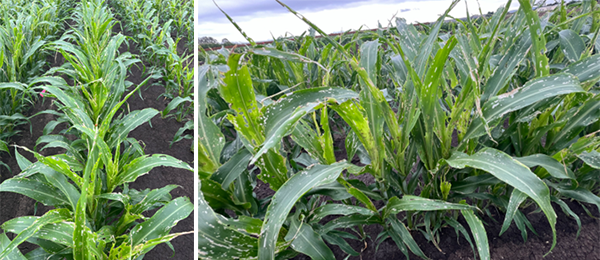
If you are seeing severe FAW damage it is likely that some of the larvae have already completed their development and left the crop to pupate in the soil.
As with other caterpillar pests, like helicoverpa, the natural mortality (death) of eggs and small larvae is high – possibly as high as 80%. However, the mortality of larger larvae (4th – 6th instar) tends to be much lower, so you can assume most larger larvae you find will survive and cause crop damage.
Making a decision about treating
Because we have not yet completed the threshold research, we cannot be definitive about a threshold at this point. The approach outlined below is a ‘best bet’ based on trial work to date and field experience.
As discussed earlier, the maximum yield loss we have had in the sorghum threshold trials (infestations between V6-V12) is 20%, so if a 20% yield loss is more than the cost of spraying the crop, then it is economically viable to treat. With current costs of insecticides and sorghum grain prices, if crops achieve at least average yields, then damaging FAW infestations would warrant treatment.
If the crop is stressed during the vegetative stage when the FAW infestation is causing defoliation, then the canopy will appear more damaged than if there was no additional stress. In this scenario, the decision to control needs to factor in the likelihood of crop recovery.
Significant crop loss occurs when a damaging infestation of FAW (more than 1 med-large larva per plant) persists in the crop for more than a week. Because the crop loss doesn’t occur overnight, you have time to check the crop thoroughly and determine how many and what size larvae are present. You may want to wait a few days and recheck the crop if you are finding a large number of small larvae, but no large larvae – to take advantage of the natural mortality that can occur.
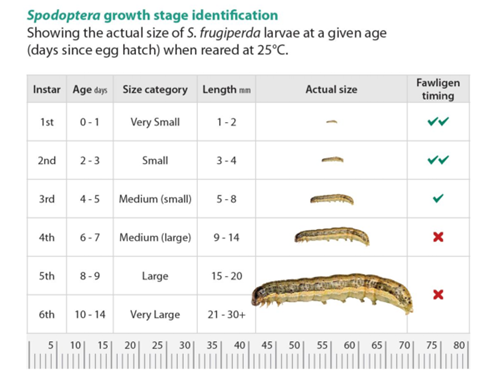
Relative size of FAW larval stages. Source: AgBitech
Assessing the efficacy of a spray
Again, the best way to determine if a spray has been effective is to destructively sample plants and assess the number of surviving larvae.
The insecticides registered or permitted for FAW all take a few days to cause maximum mortality of larvae, so assessments are best made at least 4 days post-spray. If damaging larvae have been effectively controlled, you will see a change in the crop growth within a few days as new, undamaged leaves start to push out.
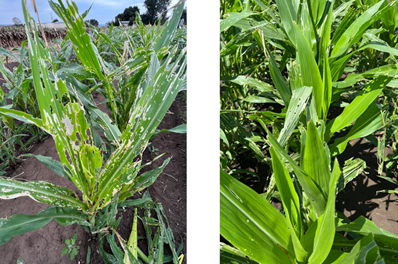
Unsprayed control (left). New leaves undamaged on plant sprayed 9 days prior (right).
Under persistent FAW pressure and ongoing egg laying in the crop, you will see egg masses and small larvae in crops that have been recently sprayed. These larvae can be killed by spray residues for 7-10 days after spraying. You will know that the residual efficacy of the spray is in decline when you start to see small-medium and medium larvae re-establishing on plants.
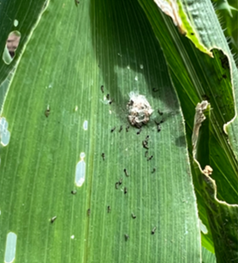
Hatching larvae dying after an application of Affirm®
FAW damage post head emergence
Large FAW larvae that are still in the crop as the head pushes out can be seen on heads, or they may move down the plant and feed on the more attractive tillers.
A similar movement of large helicoverpa larvae from the whorl to heads is observed in some seasons. However, whilst helicoverpa will happily feed directly developing grain, FAW are far less interested in grain and do not tend to persist on the heads where they are exposed to light.
In early trials where FAW were bagged onto sorghum heads at different stages of grain filling, we saw high mortality of the larvae and very little grain feeding. Under the range of scenarios we have seen to date across Queensland, we have not recorded any significant grain feeding in sorghum by FAW.
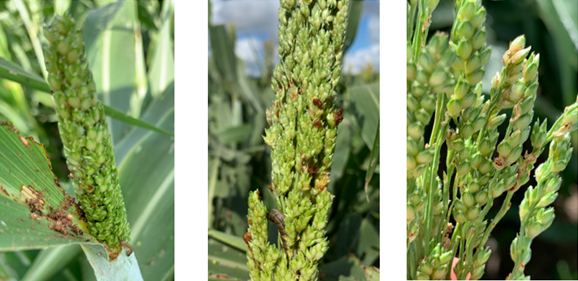
FAW damage to sorghum heads has so far been minor.
Article contributors: Melina Miles, Adam Quade and Joe Eyre (UQ, QAAFI)

Very interesting information and very informative. I wonder if the trial was done in Central QLD or North QLD I think the yield losses would be a great deal higher. We have treated FAW this year under our agronomist advice and I think that FAW has been causing us more drama than first though. I wonder if some Toxicology test could be done to see if FAW is causing more trouble than just leave damage. We have left 2 trial spots unsprayed and the difference in the crop quite remarkable.
I will share this with our clients.
Thanks for your hard work.
The Beatsheet recommends maintaining awareness of pests and beneficials in the paddock, considering the likely impact on yield potential based on crop stage and environmental conditions, and adjusting management decisions accordingly. Any pesticides used should be carefully selected and targeted based on efficacy against the target pest’s life stage, with consideration given to insecticide resistance management strategies and the potential for flaring other pests. Routine pesticide application is likely to adversely impact natural enemy populations and increase the environmental toxic load.
In areas where, Sorghum and Corn is planted continuously each season, I would advise that, you routinely spray against FAW, as possibly the pests have been endemic to the area, remember the Disease / Pests triangle ( where you have, Pests/ pathogen, favorable environment and hosts ) so, as long as you keep growing the host plants, you’re likely to have the heavy infestation
Thank you for the information. The threshold topic interests the growers in the Bowen Burdekin region. Similar information on sweet corn would be useful to the growers in the region.
I will share it with my network for wider distribution of this information.